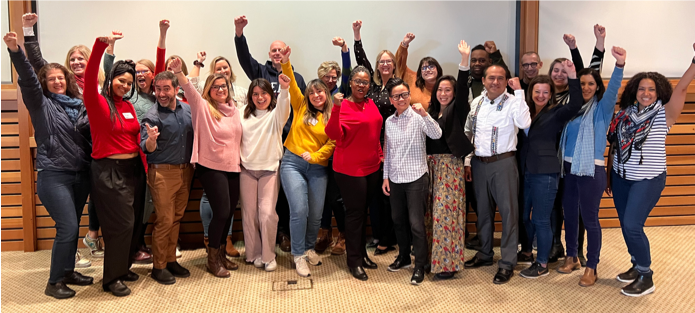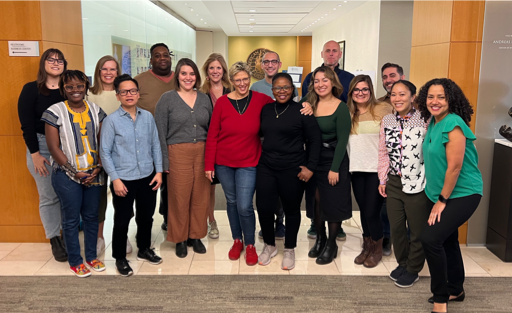Information does not equal action, but capacity building equals change
Over my years of working for a foundation and as a foundation's grantee, I have discovered that capacity building is often lumped into support for nonprofits as a little extra outside of a foundation's grant. But now having led training, learning and capacity-building programs at Spitfire Strategies, I've come to understand capacity building’s role as more than a set of trainings — it’s really helping an individual or organization change the way it sees communications and the way communications works.
The phrase “information does not equal action” is something I have posted on my desk. Just because people are taught or read something doesn’t mean they act on it. That is at the heart of why one training is not enough. While I was overseeing Spitfire’s Executive TrainingProgram (ETP), my team and I wanted to put the participant, their organization and the issue that they’re working on at the center of how we designed our capacity building. Spitfire’s ETP has been working for over 18 years to serve more than 600 nonprofit leaders from around the world. This program is a mix of in-person, online and coaching support for nonprofit leaders who want to improve their communication skills, build their organization’s capacity to communicate more effectively and make a significant change in their field through communications. This has to be more than one training.
We designed this year’s curriculum in a very intentional manner. Participants determined and selected much of the curriculum through a comprehensive assessment that they receive after they were nominated for this program. This assessment asked about their communication skills and challenges but also how their organization was positioned to do in the short and long term. We provided a buffet of communication options to choose from and asked about their expertise in each of those areas. The centerpieces of this capacity-building program were two in-person trainings. The first session, held in San Francisco, focused on strategic communications, tools and strategies to improve participants’ organizations, voice and actions. Our core focus was Spitfire’s Smart Chart, a communication planning tool. But the Smart Chart is more than just planning — it is actually helping the individual see communications in a more effective and strategic manner. This helps leaders move past vanity-driven communications like TikTok or podcasts and really dive into how communications can support their overall organizational goals. It’s understanding who the audiences and decision-makers are that they need to engage, what those individuals care about and what their barriers are to acting. We focused on each organization’s story and how the organization is engaging the media and designing its digital strategy. All these tools and trainings during this first session give leaders who normally do not spend time deep in communications the ability to understand how powerful communications can be when focused and grounded in their audience.

The second training — held in Washington, D.C., seven months later — focused on participants’ individual voice, story and how they are presenting themselves as leaders. This training was an investment in their role, vision and leadership. We had sessions that lifted up each organization’s brand and how as leaders they uphold that brand as well as the stories they need to tell to inspire their staff and external partners. We focused on creating their visual strategy and leaders’ ability to quickly send out a powerful visual social media message or a 30-second video about their opinion or a call to action from their work. We went beyond storytelling from the first session to how they would tell

that story on the front of a stage. We discussed how they are lifting up their voice and bringing their authentic self to this role. We closed the training with them writing a speech to inspire. This is more than a TED talk — it’s a powerful speech to really get their staff, board or funders engaged.
Between these two training sessions, we held webinars that were a mix of skill-building topics that participants had selected, such as campaign planning, policymaker outreach and mindful messaging. We also hosted several learning network calls, where we examined the current state of funding or role of artificial intelligence in nonprofit work. These sessions enabled each participant to share their perspectives and engage others. Surrounding all the trainings, webinars and network discussions was Spitfire’s coaching relationship. We assigned each participant a coach with a good understanding of the participant, their organization and issue. This is a long-term relationship that participants can use as their own personal coach for communications or as a way to build capacity across their entire team by engaging the coach for a training.
No individual experience in Spitfire’s ETP is the same — just as each person and need are different. Our program and coaches make sure that participants’ needs are understood and met. This is more than just a training program and even more than capacity building. This is an individual’s growth and building a stronger network of peers from across the participants and with their Spitfire coaches.
I served as a coach for many years for the ETP and still retain regular communications with the people who went through the program. Nonprofit leaders and executives need to do more than run the organization — they need to communicate about the issue and understand how communications works externally with priority audiences and internally with their staff and board. They need to know that sometimes getting on TikTok or starting a podcast is only going to please a few people rather than engage the audience as they need. Spitfire’s ETP is like a communication jetpack, enabling individuals to soar, their organization to move further, and their issues and mission to come closer to change because they have a year’s worth of capacity to build upon.
This entry was posted on Monday, November 20, 2023 at 10:51 am and is filed under Spitfire culture. You can follow any responses to this entry through the RSS 2.0 feed. Both comments and pings are currently closed.